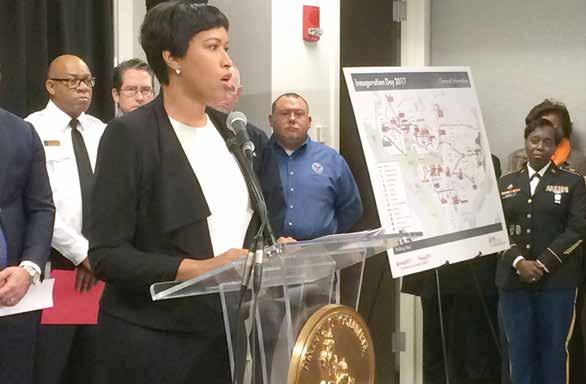
8 minute read
Health
District Named the Safest ‘State’ During Pandemic
Stacy M. Brown WI Senior Writer
As the nation continues efforts to keep the ongoing pandemic at bay and prepare for the health challenges associated with the winter season, staying safe remains a paramount concern.
Now, with holiday season travel in full swing, some states have proven safer than others and a new report reveals that the District of Columbia counts as the safest place in the nation.
Researchers at the personal finance website, WalletHub, compared all 50 states and the District of Columbia across five key metrics: rates of COVID-19 transmission; positive testing; hospitalizations; deaths; and the share of the eligible population receiving vaccinations.
With an overall score of 91.30, D.C. outdistanced Connecticut (86.64), Rhode Island (86.53), Florida (85.90) and Massachusetts (85.43).
Vermont (82.17), California (81.17), Maryland (78.88), New York (78.86) and Hawaii (77.96) rounded out the top 10.
Virginia finished 19th with a 67.14 overall score while Wyoming (18.56) claimed the spot of least safe.
The District of Columbia also enjoys the lowest positive test rate while Pennsylvania has the highest rate of vaccinations.
Hospitalizations were lowest in Hawaii, Mississippi, North Carolina, Louisiana and Alabama. Conversely, New Mexico, Colorado, South Dakota, Wyoming and Montana had the highest hospitalization rates, researchers found.
D.C., Florida, Kansas, Mississippi and Oklahoma registered the lowest death rates, while West Virginia, Idaho, Montana, Kentucky and Wyoming reported the highest death rates.
Politically speaking, the average rank of Blue States proved far better than Red States.
“Everyone should continue to socially distance and wear masks as recommended by the CDC,” stated WalletHub expert David F. Merrick, the director of Emergency Management and Homeland Security Program at Florida State University’s College of Social Sciences and Public Policy.
“These simple measures will enable our communities to handle the back half of this pandemic as vaccines roll out,” Merrick said.
When asked how the federal government can help states increase vaccination rates, Rupali J. Limaye said the feds could guide states as needed.
“States will determine how to distribute the vaccine but the federal government can help by guiding them as to how best to distribute it,” said Limaye, an associate scientist in the Department of Health, Epidemiology, and Health, Behavior and Society at Johns Hopkins Bloomberg School of Public Health.
“People must continue to stay home if they can, social distance and wear a mask,” Limaye continued.
“The vaccine rollout will take some time but once a person is eligible, they should get the vaccine. The vaccine is not only effective but has been tested rigorously for safety. All these things together will help protect communities and lead to state recoveries,” he said. WI
TESTING from Page 1
ious grades and disciplines have been tasked with giving to students throughout the grading period.
Some teachers, including one who spoke to The Informer on the condition of anonymity, say these assessments, called required curricular tasks (RCTs), haven’t sparked academic growth because they don’t take into account pandemic-related skills gaps.
“Sometimes, students find RCTs frustrating because they’re based on writing articles and we have students who struggle to write their names and sentences,” said the second grade teacher who works at a Southeast-based public school.
In addition to RCTs, regular lessons and small-group interventions, the second grade teacher said DCPS has made them responsible for giving students weekly phonics assessments. Teachers in this position, she said, often have little latitude in changing the test or straying away from a data collection mandate that’s been described as purposeless.
As the Southeast teacher regeared toward completing the writing tasks rather than going through the natural order of the lessons.”
5 Mayor Muriel Bowser. (Photo courtesy E. Sarai, VOA News via Wikimedia commons)
5 James Isreal - Washington Teachers Union Vice President for Junior High Schools (Courtesy photo/Facebook grab)
counted, instructors are encouraged to spend their planning period, not preparing engaging lessons, but uploading testing data onto an online platform that DC Public Schools [DCPS]’ central office can access.
“The RCTs are not meeting them where their skill levels are,” the teacher said. “Our practice has been
THE DEBATE SURROUNDING STANDARDIZED TESTS
DCPS didn’t respond to The Informer’s inquiry about the long-term plans for RCTs and elements of the data collection process.
RCTs, introduced during virtual instruction last school year, count among several standardized tests given to District public school students. Other assessments include: ANet English and math tests; MAP math and science tests; i-Ready; Reading Inventory; and DIBELS, the phonetic awareness test to which the second grade teacher referred.
These tests, taken throughout the year, eventually snowball into PARCC, the annual assessment that measures students’ college and career preparedness and dictates a school’s standing on the STAR Framework.
During the pandemic, the Office of the State Superintendent of Education [OSSE], at the behest of teachers and parents, secured PARCC’s cancellation.
But over the last few months, Acting State Superintendent Dr. Christina Grant has remained adamant about students taking PARCC and other assessments this school year to measure what has been described as learning loss.
However, some teachers like James Isreal said the focus should be on the social and emotional effects of the pandemic, not additional assessments and data collection. Though Isreal no longer teaches a core subject, which precludes him from doling out RCTs more often, he said he vicariously experiences his colleagues’ apprehension about tackling these tasks while addressing matters often requiring their immediate attention.
“There are countless physical and verbal altercations that are happening in schools across the District,” said Isreal, a teacher at Hart Middle School in Southeast and Washington Teachers’ Union [WTU] vice president for junior high schools.
“Requiring ALL RCTs to be complete without discretion just to have data when teachers don't have enough time to really teach the standards to TESTING Page 21
TESTING from Page 20
mastery and students are already several academic years behind, just makes the school-to-prison pipeline [more] evident,” he said.
FIGHTING THE GREATER FORCES AT PLAY
Laura Fuchs, a District public school teacher of more than a decade, described RCTs and the phenomenon of data collection in DCPS as part of the District’s relationship with the Broad Center, an educational leadership program completed by Deputy Mayor for Education Paul Kihn, DCPS Chancellor Lewis Ferebee and former DCPS chancellors Antwan Wilson and Kaya Henderson.
Grant’s predecessor, Hanseul Kang, left OSSE earlier this year to lead the Broad Center at the Yale School of Management. This program, financed by philanthropist Eli Broad, has been designed to support education leaders, particularly those running school systems and charter networks, as they endeavor to increase organizational effectiveness.
The degree to which school leaders have been able to do so has been questioned, not only by Fuchs, but her WTU colleagues and those affiliated with the DC Caucus of Rank-and-File Educators. Over the years, Fuchs has pushed back against what she described as the proliferation of standardized testing and data collection.
Fuchs said tests and data shouldn’t take priority at a time when students, and teachers, are struggling to reacclimate themselves to the school environment, However, despite some attempts by colleagues to circumvent the data collection mandate, Fuchs said there appears to be no signs of change, at least for the time being.
“They love making reports. We have always been getting pressured this way,” said Fuchs, who teaches at H.D. Woodson High School in Northeast.
“DCPS has added even more standardized tests. They want to standardize English, math, science and social studies and have a test they can track for some big data reporting company that they pay a bucketload of money to apparently help us fix things by putting numbers in a glorified spreadsheet,” she said. wi ZONING from Page 12
that is user-friendly and provides community input, it’s a proud moment,” Turner said. “This is a major achievement and we can move forward to make sure it’s implemented the way that we want.”
Glaros asked if the planning department would be ready to accept applicants on the first day the zoning ordinance becomes law.
“The answer to that is an emphatic, ‘yes,’” said Derick Berlage, the county’s deputy planning director. “The planning department is ready to work with the new ordinance.”
If a property owner submits a zoning proposal prior to April 1, it would need to be reviewed by planners and then by the zoning hearing examiner. That means new proposals will not be accepted for review before the District Council until after the new zoning ordinance goes into effect.
Before the council could officially grant final approval, it needed to vote on 10 zoning requests from municipal officials that included seven from the city of Greenbelt. Council unanimously approved recommendations from the county’s planning board on eight of the 10 requests.
Council member Jolene Ivey (D-District 5) of Cheverly voted in favor of the municipalities for two of the zoning requests. One included the town of Bladensburg to label nearly 41 acres as “commercial neighborhood” versus “commercial service” and slightly more than an acre in Greenbelt as “agricultural and preventions” as opposed to the planning board’s recommendation of “residential, rural.”
County officials began the zoning rewrite in 2014 and approved a new ordinance in October 2018 to make the obsolete language easier to understand, eliminate dozens of zoning districts and make the process more streamlined.
The process continued in 2019 with in-person and virtual public hearings to combine certain zoning districts such as “industrial, employment” which incorporates four of the previous designations. Officials exchanged terms of certain zones from “heavy industrial” to “industrial, heavy” and “rural residential” to “residential, rural.”
The $534 million University of Maryland Capital Region Medical Center, near the Largo Town Center Metro station, would be labeled “regional transit-oriented, high intensity.” This zoning designation focuses on transit centers anchored by Metrorail stations with various businesses and apartments and/or condominiums.
“A lot of people said it couldn’t get done,” said council member Derrick Leon Davis (D-District 6) of Upper Marlboro. “It took effort over many years to get us to a place where in April, we will have a new transit-oriented focus and a thoughtful zoning code that looks at Prince George’s County’s 500 square miles. That is a yeoman’s task.” WI @jabariwill
Dreaming of homeownership?
DC4ME provides D.C. government employees, including independent agencies and other government-based instrumentatlities, a first trust mortgage at a reduced interest rate.


